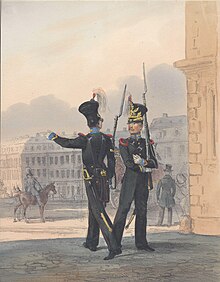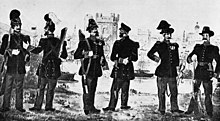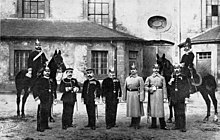Grand Ducal Badisches Gendarmeriekorps
The Grand Duchy of Baden Gendarmerie Corps formed the gendarmerie of the Grand Duchy of Baden from 1829 to 1918 . Until the military convention with the Kingdom of Prussia on November 25, 1870, it was part of the Baden Army , after which it was exclusively subordinate to the Ministry of the Interior in Karlsruhe , where the headquarters of the corps command was located. The last commanding officer was Major General August Anheuser (1846–1933) from 1905 to March 1919 .
history
Compared to other German federal states , whose gendarmeries were usually founded in the 1810s on the model of the French gendarmerie impériale (e.g. Kingdom of Prussia and Kingdom of Bavaria in 1812, Kingdom of Hanover in 1815, Grand Duchy of Oldenburg in 1817), the Baden Corps relatively late.
Around 1900, the so-called state police in the cities of Mannheim , Heidelberg , Karlsruhe , Pforzheim , Rastatt , Baden , Freiburg im Breisgau and Constance existed as further police authorities in Baden . It was not subordinate to the local authorities but, like the gendarmerie, to the Ministry of the Interior . The municipal police of the (small) towns and communities, however, were subordinate to the local mayor.
founding
The corps was established by a decree of Grand Duke Ludwig of December 1, 1829. This was preceded by a grand ducal edict of October 3:
The constant care for the diligent handling of public peace and order and security in the interior of the state of Baden have therefore moved ... to set up an armed, militarily organized corps called the "Gendarmerie Corps" and to maintain public peace, order and security i Transfer to the interior of the state of Baden from December 1, 1829.
(Source quoted from: "150 years ago", p. 23)
On December 31, 1831, Ludwig's successor, Grand Duke Leopold, passed a "Law on the Gendarmerie", in which u. a. the relationship with the civil and military authorities was clearly regulated.
After that, the corps was subordinate to the Ministry of the Interior in all official matters and was not subordinate to any other civil authority. Although part of the army, military services had no authority over the corps. However, the gendarmerie was obliged to comply with requests from the judicial and administrative authorities without delay, with the responsibility for the purely legal execution of the requests resting solely with the requesting authority. It was expressly pointed out in Section 20 that the civil authorities had no right to use the gendarmes for running errands or other unrelated activities. The gendarmerie officers were charged with preventing such misuse.
In a joint operation with the army, gendarmerie officers had the supreme command in the case of the same rank . In the case of a joint operation under the leadership of a senior army officer, he should consider the gendarmerie officer's requests. The rank of gendarmes corresponded to the corporal of the army, brigadiers to that of the sergeants , and sergeants to that of the sergeants or sergeants of the army, but had priority over these during joint operations. In principle, the gendarmes were subject to military jurisdiction . This regulation probably existed until at least 1870, possibly until the end of the monarchy in 1918.
structure
The strength of the corps was initially 248 men, but grew to 560 gendarmes by the end of the First World War in 1918. Analogous to the six districts of Baden that existed in 1829, it was divided into six divisions when it was founded, which in turn consisted of several gendarmerie brigades. As in France and other German states, a gendarmerie brigade was usually composed of one brigadier and four gendarmes.
As part of the Baden Army, the corps was subordinate to both the War Ministry and the Ministry of the Interior (see below). It was led by the corps commander , a major , lieutenant colonel , colonel or general . The division heads were presumably captains .
A decisive change in the structure of the corps resulted from the military convention between Baden and Prussia in 1870, which ended the independence of the Baden army, which was integrated into the Prussian army. Since the military status of the gendarmerie remained unchanged, from this point on it formed the only military in Baden and was still subordinate to the Grand Duke. This regulation corresponded to the conditions in other German federal states without an independent military. B. in the Grand Duchy of Oldenburg with its Grand Ducal Gendarmerie Corps .
By 1900 at the latest, the corps was divided into four districts, which in turn were divided into districts. The district officers were subordinate to the corps commander in Karlsruhe. The districts were led by chief sergeants. At that time, but no later than 1914, gendarmes and sergeants were auxiliary officers of the public prosecutor's office .
The prerequisite for joining the corps in 1829 was at least six years of military service with impeccable leadership and knowledge of reading, writing and arithmetic. The age of recruitment was between 25 and 36 years of age.
Uniforms, armaments, equipment
The uniforms were based on that of the Prussian Landgendarmerie . Gray trousers with blue stripes were worn with a green uniform skirt, which was, however, a much darker shade (so-called Russian green) than the Prussian gendarmerie skirt. There were also black Fußgamaschen and for the gendarmes a shako with white hair bush, for the officers a cocked hat . The shako was apparently replaced by a helmet in the 1840s. In 1869, the so-called Pickelhaube was introduced based on the Prussian model, as well as blue-black trousers based on the Prussian model. Both on the Shako and the helmet was the insignia of the Badische Cross worn. A wide-brimmed hat was apparently worn between 1863 and 1869 (see uniform table). A peaked cap was probably introduced from 1869 at the latest . The uniforms clearly differentiated the corps from the Baden military. Although the uniform cut was apparently always identical, Baden troops like the Prussian Army were generally in blue uniform with the exception of the Dragoons (light blue).
The gendarmes were initially armed with a percussion rifle , a pistol and a saber . The saber was later replaced by a yatagan , which in turn was replaced by an officer's sword in the 1870s . The rifles were replaced by carbines in the 1880s .
How many of the gendarmes were mounted is unknown. The only thing that is certain is that a special mounted department was set up in 1890. As far as is known, this was a Baden peculiarity, since in other German gendarmes the gendarmes were on duty either on foot or on horseback, but not in a special formation.
As in other German gendarmerie, a field-gray uniform was introduced in Baden by a regulation of April 26, 1917 , which corresponded to the uniforms of the Prussian Army. The tunic and the so-called M 1915 blouse were field gray , the trousers gray. It is unknown whether, and if, to what extent this regulation was implemented by the end of the First World War. It was definitely ended with the establishment of the Baden Republic , when the military status of the gendarmerie was abolished in 1920 and the gendarmes were given the status of state officials (see below).
The Baden War Ministry was responsible for equipping and arming the gendarmerie until the military convention of 1870, but accounting was always carried out via the budget of the Interior Ministry, which was also responsible for the use of the corps.
During the Baden Revolution and the Imperial Constitutional Campaign in 1848/49, which in Baden and in the whole of southwest Germany showed a much greater democratic dynamic than in other parts of the German Confederation , the Gendarmerie Corps was temporarily close to being dissolved because it was used by the revolutionaries as a monarchist instrument of rule was viewed. For a time, at least regionally, the service came to a complete standstill or the gendarmes behaved passively, also at the direction of the corps command. After the end of the revolution, the corps, like the army itself, was reorganized with Prussian support.
Salary around 1884
Little is known about the salaries of the Baden gendarmerie. A salary list with the annual salaries has been preserved from 1884:
- Oberwachtmeister: 1500 marks
- Sergeant 1st class: 1150 M.
- Sergeant 2nd class: 1050 M.
- Gendarme 1st class: 950 M.
- 2nd class gendarme: 875 M.
- Gendarme 3rd class: 800 M.
Source: "150 Years", p. 39.
Gendarmerie school from 1908
On October 1, 1908, the Gendarmerie School was set up at the headquarters of the Corps Command in Karlsruhe at Rüppurerstraße 31, presumably based on the Prussian model (see there), in order to centralize the previously decentralized training of gendarmerie trainees. It had previously taken place in the four districts of Constance, Freiburg, Karlsruhe and Mannheim under the direction of so-called instructor watchmen.
The so-called training course lasted three and a half months out of a total of six months of training. The first headmaster was Major Stemmermann, who also taught a few subjects. The civilian teacher was the senior teacher Fischer at the Karlsruhe Municipal School. A Grand Ducal Public Prosecutor was designated to teach the legal subjects , but his name had not yet been determined when the school opened. A sergeant was provided for practical police training.
Restructuring 1918/19. From the state police force to the Baden gendarmerie
In the course of the November Revolution of 1918, the gendarmerie was briefly disbanded and converted into the state police force. For a short time, the gendarmes were now known as Landesschutzmann. The most important feature of the restructuring was the (short-term) abolition of the military status, whereby the combatant status was lost. In April 1919 the troop was re-established as the Badische Gendarmerie. At that time, the chief of the gendarmerie was the former public prosecutor and now gendarmerie colonel Hermann Kuenzer as the commander of the Baden state police force. The military jurisdiction existed until August 17, 1920. From this point in time the officers and gendarmerie officers also had the right to vote.
In 1921 the rank designations were partially changed. The Police Act of June 1923, which replaced the Act of 1831 (see above), brought about a radical change. The corps command and the district commands were abolished and integrated into the Ministry of the Interior, which eliminated the double subordination of the gendarmes to military and civilian superiors. The uniforms - apart from the change in the grand ducal emblem - largely corresponded to that of the old corps.
Culture of remembrance
To mark the 150th anniversary of the founding of the Corps was one of the most Dec. 1, 1979 the police union , state district Baden-Wuerttemberg , aligned ceremony in the town hall of Merzhausen instead.
See also
literature
- August Steinheuser: History of the Großh (educational). Baden Gendarmerie Corps from its establishment in 1829 up to and including 1899 , Karlsruhe (Braun) 1899.
- The fighting in southwest Germany 1919–1923 . Edited on behalf of the Reich Ministry of War and published by the Research Institute for War and Army History, Berlin (Mittler) 1939 ( depictions of the post-war battles of German troops and volunteer corps , Volume 5).
- Police Union . Baden-Württemberg district (Ed.): 150 years ago. Establishment of the Grand Ducal Badische Gendarmerie , undated (Hilden, Verlag Deutsche Polizei), undated (1979) (The “Law on the Gendarmerie” of December 31, 1831 is reproduced on pages 65–70).
- Eberhard Laux: The modern state and its administration. Contributions to the history of development since 1700 , Stuttgart 1988. ISBN 3-515-07168-7
- Ingo Löhken: Police Uniforms of the South German States 1872–1932. Baden, Bavaria, Hesse, Württemberg, Reichslande , Friedberg / H. 1988. ISBN 3-7909-0328-0
- Heinrich Ambros Eckert / Dietrich Monten : The German army. Based on the uniform work from the years 1835 to 1843 , Dortmund (Harenberg) 1990. ISBN 3-611-00132-5 .
- Bernd Wirsing: The history of the gendarmerie corps and their predecessor organizations in Baden, Württemberg and Bavaria, 1750-1850 , Phil. Diss. University of Konstanz 1991 (machine manuscript).
- Manfred Teufel: The southwest German police in the government and people's state. Data - facts - structures 1807–1932 , Hohenkirchen / Obb. 1999. ISBN 3-927983-41-1
- Bernhard Schreiber: The security forces in the Republic of Baden 1918–1933. From the People's Armed Forces to the Unified Police, Glottertal 2002. ISBN 3-00-009614-0



